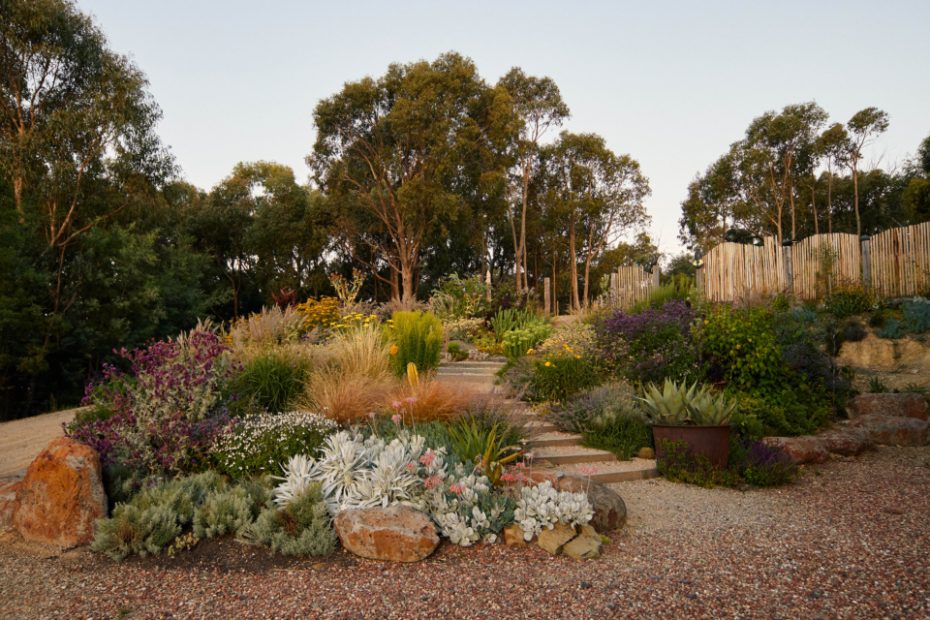A Potter’s Abundant Native Garden In Hepburn, Victoria
Gardens
Bluestone boulders help retain the sloping site of Bridget Bodenham’s sloping garden.
The main steps in the garden are made from sleepers and recycled concrete dust. ‘We generally sit on the steps for a morning coffee and I do some weeding,’ says Bridget.
The view from the steps.
The fence is made from tomato stakes and Bluegum posts.
Bridget says of the beautiful white foliage in the bottom right corner; ‘It’s iscelmisia semicordata. I love its dry fury leaf.’
In this garden you’ll find; Achillea millefolium (yarrow), Verbena (vervain), Echinops (blue globes), Miscanthus sinensis (Chinese silver grass), Stipa grass (needle grass), ‘Strictus’ Cactus, Senecio serpens (blue chalkstick), Agave, Sedum cotyledon (Autumn joy), Salvia nemorosa (woodland sage).
The grasses capture the evening light beautifully.
Lillies, yarrow liquorice plant, grasses, sedum (stonecrop) and Salvia nemorosa (woodland sage).
Purple salvias and dark Aeonium (black rose).
From the top of the site, looking down onto the pond.
The garden also holds; Nepeta (catnip), Phlomis (Jerusalem sage), Helichrysum petiolare (silver light), Alliums, Rosemary, Oregano, Curry plant, Santolina (cotton lavender), Helichrysum petiolare (licorice plant), Cardoon (artichoke thistle), Bronze fennel, Lambs ears, Echium Phlomis (Mary flower).
Bridget’s studio.
Verbena and buddleia (butterfly bush).
An artist rarely starts on a canvas another artist has begun. Unless of course, that canvas is a garden.
When potter Bridget Bodenham moved her studio and practice onto a five acre section on her mum’s property in Hepburn in 2018, she also inherited a beautiful garden designed and planted by artist and gardener Lily Langham.
With a verdant and abundant base to build off, Bridget has added to Lily’s work in the years since, taking cuttings and spreading seeds to different areas to extend the canvas and incorporate new plants, including cactus, natives and herbs.
There have been failures and learnings along the way; in certain areas poor soil quality stymied growth, and whilst some plants suffered from too much moisture (the cacti), others hankered for more. But, as Bridget says undeterred, ‘trial and error always builds knowledge!’
With plenty of mushroom compost, sand and new soil, her plants now sit in nutrient-rich ground and her flourishing, layered garden is humming with life, colour and texture.
Bluestone boulders are dotted around the garden — ‘they’re nice to sit on, especially when the sun warms them,’ says Bridget. She’s also used recycled and crushed bricks, cement and tiles for the pathways. These add form and structure amongst the swaying grasses and perennial blooms.
‘Combining contrasting foliage and form is what I’m most interested in exploring in the garden,’ says Bridget of her latest plantings; red kangaroo paw (Anigozanthos rufus) and Japanese blood grass (imperata cylindrica).
‘I’m always adding things and viewing it from all angles, always noticing something new,’ she says.
The garden, and the surrounding bushland, have become the main inspirations for Bridgets’ work. Her ‘bee bowls’ (petal edged plates mounted on stakes and filled with water) were born from the desire to have something beautiful and useful to look at in the garden.
‘If you want to see my work, see my garden first,’ she says. ‘Each season brings something new and different, it’s changing all the time and becoming its own.’
